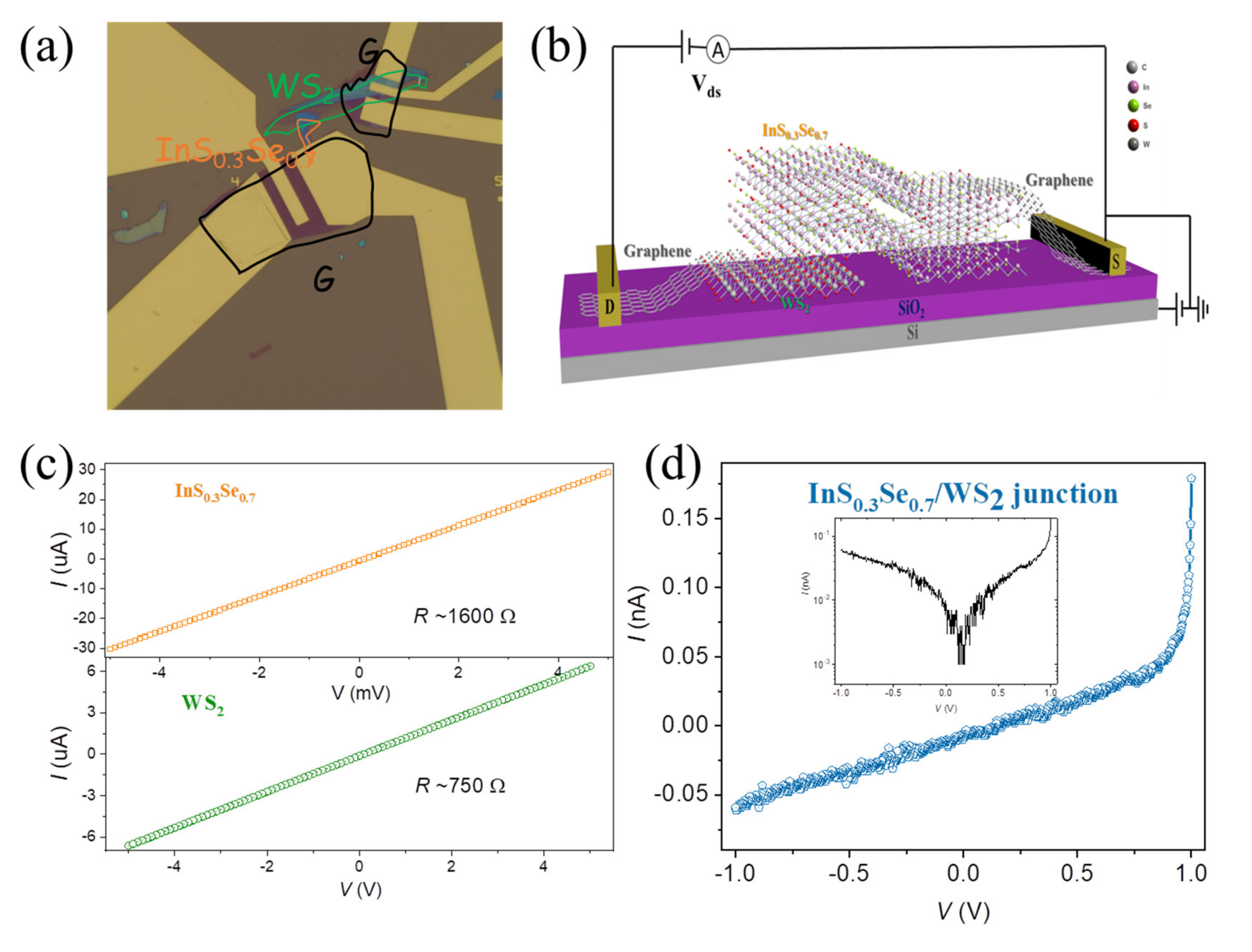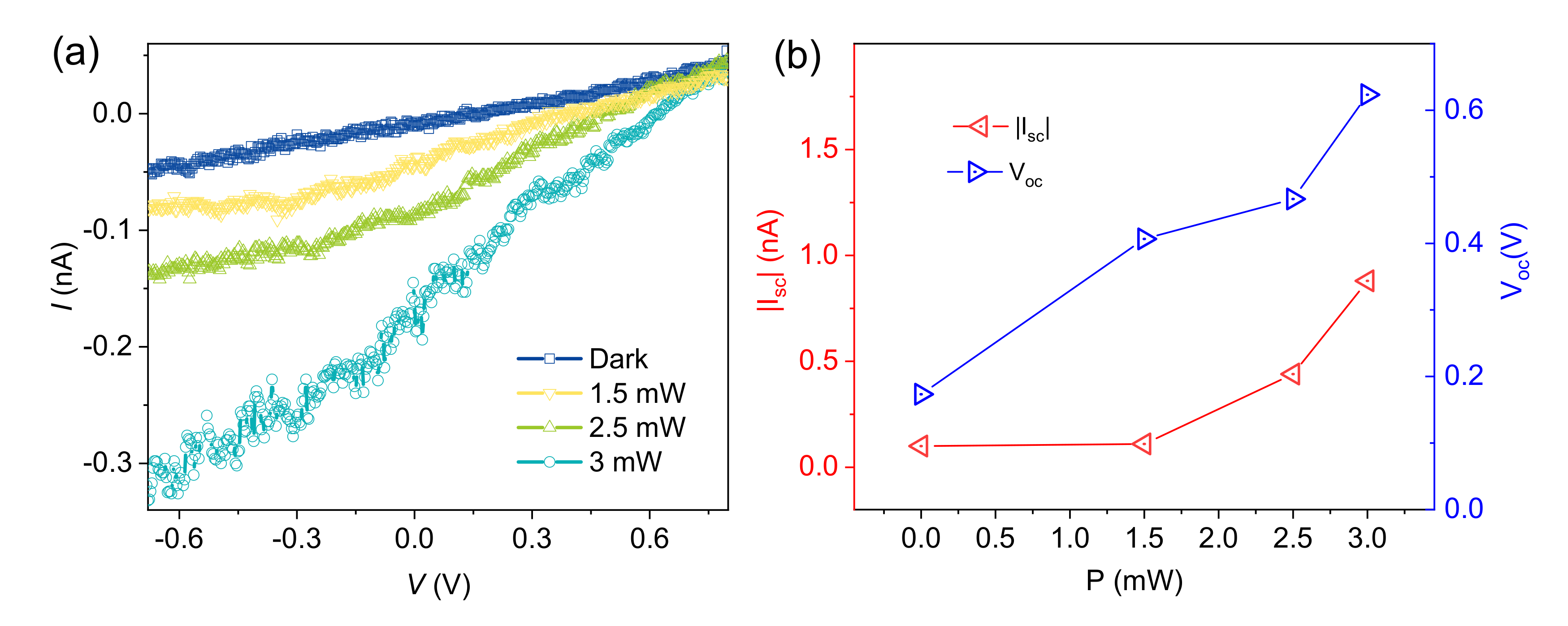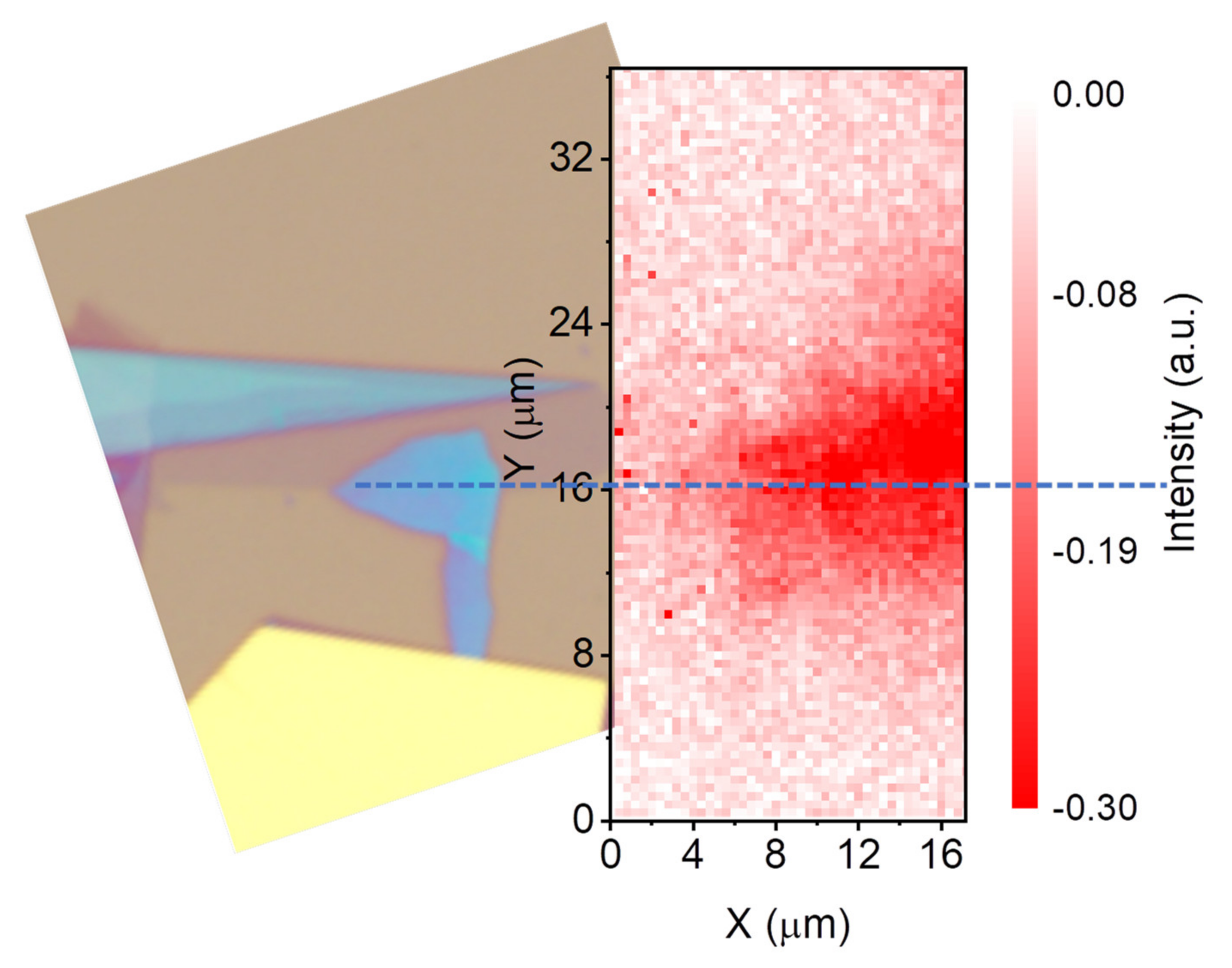Low-Powered Photodetector Based on Two-Dimensional InS0.3Se0.7/WS2 Heterostructure
Abstract
1. Introduction
2. Results and Discussion
3. Conclusions
Supplementary Materials
Author Contributions
Funding
Institutional Review Board Statement
Informed Consent Statement
Data Availability Statement
Conflicts of Interest
References
- Miao, J.; Zhang, L.; Wang, C. Black phosphorus electronic and optoelectronic devices. 2D Mater. 2019, 6, 032003. [Google Scholar] [CrossRef]
- Shang, H.; Chen, H.; Dai, M.; Hu, Y.; Gao, F.; Yang, H.; Xu, B.; Zhang, S.; Tan, B.; Zhang, X.; et al. A mixed-dimensional 1D Se–2D InSe van der Waals heterojunction for high responsivity self-powered photodetectors. Nanoscale Horiz. 2020, 5, 564. [Google Scholar] [CrossRef] [PubMed]
- Mondal, S.; Basak, D. Very high photoresponse towards low-powered UV light under low-biased condition by nanocrystal assembled TiO2 film. Appl. Surf. Sci. 2018, 427, 814–822. [Google Scholar] [CrossRef]
- Su, L.; Yang, W.; Cai, J.; Chen, H.; Fang, X. Self-Powered Ultraviolet Photodetectors Driven by Built-In Electric Field. Small 2017, 13, 1701687. [Google Scholar] [CrossRef]
- Xu, Z.; Lin, S.; Li, X.; Zhang, S.; Wu, Z.; Xu, W.; Lu, Y.; Xu, S. Monolayer MoS2/GaAs heterostructure self-driven photodetector with extremely high detectivity. Nano Energy 2016, 23, 89–96. [Google Scholar] [CrossRef]
- Wang, H.; Chen, H.; Li, L.; Wang, Y.; Su, L.; Bian, W.; Li, B.; Fang, X. High Responsivity and High Rejection Ratio of Self-Powered Solar-Blind Ultraviolet Photodetector Based on PEDOT:PSS/β-Ga2O3 Organic/Inorganic p–n Junction. J. Phys. Chem. Lett. 2019, 10, 6850–6856. [Google Scholar] [CrossRef]
- Xiao, R.; Lan, C.; Li, Y.; Zeng, C.; He, T.; Wang, S.; Li, C.; Yin, Y.; Liu, Y. High Performance Van der Waals Graphene–WS2–Si Heterostructure Photodetector. Adv. Mater. Interfaces 2019, 6, 1901304. [Google Scholar] [CrossRef]
- Lan, C.; Li, C.; Wang, S.; He, T.; Zhou, Z.; Wei, D.; Guo, H.; Yang, H.; Liu, Y. Highly responsive and broadband photodetectors based on WS2–graphene van der Waals epitaxial heterostructures. J. Mater. Chem. C 2017, 5, 1494–1500. [Google Scholar] [CrossRef]
- Deilmann, T.; Thygesen, S. Interlayer Trions in the MoS2/WS2 van der Waals Heterostructure. Nano Lett. 2018, 18, 1460–1465. [Google Scholar] [CrossRef]
- Alamri, M.; Gong, M.; Cook, B.; Goul, R.; Wu, J.Z. Plasmonic WS2 Nanodiscs/Graphene van der Waals Heterostructure Photodetectors. ACS Appl. Mater. Interfaces 2019, 11, 33390–33398. [Google Scholar] [CrossRef]
- Yang, G.; Shao, Y.; Niu, J.; Ma, X.; Lu, C.; Wei, W.; Chuai, X.; Wang, J.; Cao, J.; Huang, H.; et al. Possible Luttinger liquid behavior of edge transport in monolayer transition metal dichalcogenide crystals. Nat. Commun. 2020, 11, 659–667. [Google Scholar] [CrossRef] [PubMed]
- Hocheon, Y.; Keun, H.; Md. Hasan, R.; Seongjae, C. Recent Advances in Electrical Doping of 2D Semiconductor Materials: Methods, Analyses, and Applications. Nanomaterials 2021, 11, 832. [Google Scholar]
- Deep, J.; Vinod, K.; Lincoln, J.; Tobin, J.; Mark, C. Emerging Device Applications for Semiconducting Two-Dimensional Transition Metal Dichalcogenides. ACS Nano 2014, 8, 1102–1120. [Google Scholar]
- Lu, Z.; Neupane, G.P.; Jia, G.; Zhao, H.; Qi, D.; Du, Y.; Lu, Y.; Yin, Z. 2D Materials Based on Main Group Element Compounds: Phases, Synthesis, Characterization, and Applications. Adv. Funct. Mater. 2020, 30, 2001127. [Google Scholar] [CrossRef]
- Zhou, C.; Zhang, S.; Lv, Z.; Ma, Z.; Yu, C.; Feng, Z.; Chan, M. Self-driven WSe2 photodetectors enabled with asymmetrical van der Waals contact interfaces. NPJ 2D Mater. Appl. 2020, 4, 46. [Google Scholar] [CrossRef]
- Ning, J.; Zhou, Y.; Zhang, J.; Lu, W.; Dong, J.; Yan, C.; Wang, D.; Shen, X.; Feng, X.; Zhou, H.; et al. Self-driven photodetector based on a GaSe/MoSe2 selenide van der Waals heterojunction with the hybrid contact. Appl. Phys. Lett. 2020, 117, 163104. [Google Scholar] [CrossRef]
- Tan, C.; Wang, H.; Zhu, X.; Gao, W.; Li, H.; Chen, J.; Li, G.; Chen, L.; Xu, J.; Hu, X.; et al. Self-Powered Photovoltaic Photodetector Based on a Lateral WSe2-WSe2 Homojunction. ACS Appl. Mater. Interfaces 2020, 12, 44934–44942. [Google Scholar] [CrossRef]
- Chen, J.; You, D.; Zhang, Y.; Zhang, T.; Yao, C.; Zhang, Q.; Li, M.; Lu, Y.; He, Y. Highly Sensitive and Tunable Self-Powered UV Photodetectors Driven Jointly by p-n Junction and Ferroelectric Polarization. ACS Appl. Mater. Interfaces 2020, 12, 53957–53965. [Google Scholar] [CrossRef]
- Xu, Y.; Liu, C.; Guo, C.; Yu, Q.; Guo, W.; Lu, W.; Chen, X.; Wang, L.; Zhang, K. High performance near infrared photodetector based on in-plane black phosphorus p-n homojunction. Nano Energy 2020, 70, 104518. [Google Scholar] [CrossRef]
- Tan, C.; Yin, S.; Chen, J.; Lu, Y.; Wei, W.; Du, H.; Liu, K.; Wang, F.; Zhai, T.; Li, L. Broken-Gap PtS2/WSe2 van der Waals Heterojunction with Ultrahigh Reverse Rectification and Fast Photoresponse. ACS Nano 2021, 15, 8328–8337. [Google Scholar] [CrossRef]
- Lei, S.; Ge, L.; Sina, N.; Antony, G.; Rajesh, K.; Lou, J.; Manish, C.; Hisato, Y.; Gautam, G.; Robert, V.; et al. Evolution of the Electronic Band Structure and Efficient Photo-Detection in Atomic Layers of InSe. ACS Nano 2014, 8, 1263–1272. [Google Scholar] [CrossRef]
- Hao, Q.; Liu, J.; Dong, W.; Yi, H.; Ke, Y.; Tang, S.; Qi, D.; Zhang, W. Visible to near-infrared photodetector with novel optoelectronic performance based on graphene/S-doped InSe heterostructure on h-BN substrate. Nanoscale 2020, 12, 19259–19266. [Google Scholar] [CrossRef]
- Guo, H.; Zhang, Z.; Huang, B.; Wang, X.; Niu, H.; Guo, Y.; Li, B.; Zheng, R.; Wu, H. Theoretical study on the photocatalytic properties of 2D InX(X = S, Se)/transition metal disulfide (MoS2 and WS2) van der Waals heterostructures. Nanoscale 2020, 12, 20025–20032. [Google Scholar] [CrossRef] [PubMed]
- Hao, Q.; Yi, H.; Su, H.; Wei, B.; Wang, Z.; Lao, Z.; Chai, Y.; Wang, Z.; Jin, C.; Dai, J.; et al. Phase Identification and Strong Second Harmonic Generation in Pure ε-InSe and Its Alloys. Nano Lett. 2019, 19, 2634–2640. [Google Scholar] [CrossRef] [PubMed]
- Yan, F.; Zhao, L.; Amalia, P.; Hu, P.; Wei, X.; Luo, W.; Zhang, D.; Lv, Q.; Feng, Q.; Shen, C.; et al. Fast, multicolor photodetection with graphene-contacted p-GaSe/n-InSe van der Waals heterostructures. Nanotechnology 2017, 28, 27LT01. [Google Scholar] [CrossRef]
- Hao, Q.; Liu, J.; Wang, G.; Chen, J.; Gan, H.; Zhu, J.; Ke, Y.; Chai, Y.; Lin, J.; Zhang, W. Surface-Modified Ultrathin InSe Nanosheets with Enhanced Stability and Photoluminescence for High-Performance Optoelectronics. ACS Nano 2020, 14, 11373–11382. [Google Scholar] [CrossRef]
- Yang, Z.; Jie, W.; Mak, C.-H.; Lin, S.; Lin, H.; Yang, X.; Yan, F.; Lau, S.P.; Hao, J. Wafer-Scale Synthesis of High-Quality Semiconducting Two-Dimensional Layered InSe with Broadband Photoresponse. ACS Nano 2017, 11, 4225–4236. [Google Scholar] [CrossRef]
- Dai, M.; Chen, H.; Wang, F.; Hu, Y.; Wei, S.; Zhang, J.; Wang, Z.; Zhai, T.; Hu, P. Robust Piezo-Phototronic Effect in Multilayer γ-InSe for High-Performance Self-Powered Flexible Photodetectors. ACS Nano 2019, 13, 7291–7299. [Google Scholar] [CrossRef] [PubMed]
- Chen, Z.; Johan, B.; Abhay, S. A high performance graphene/few-layer InSe photo-detector. Nanoscale 2015, 7, 5981–5986. [Google Scholar] [CrossRef]
- Nadine, L.; Jonas, G.R.; Guillaume, F.; Matthew, H.; Daniel, T.; Roman, G.; Richard, J.W. Optical second harmonic generation in encapsulated single-layer InSe. AIP Adv. 2018, 8, 105120. [Google Scholar]
- Li, H.; Han, X.; Pan, D.; Yan, X.; Wang, H.-W.; Wu, C.; Cheng, G.; Zhang, H.; Yang, S.; Li, B.; et al. Bandgap Engineering of InSe Single Crystals through S Substitution. Cryst. Growth Des. 2018, 18, 2899–2904. [Google Scholar] [CrossRef]
- Srinivasa, R.; Lu, Y.; Rajesh, K.; Raman, S.; Liao, C.; Karukanara, M.; Cheng, C.; Chou, F.; Chen, Y. High Performance and Bendable Few-Layered InSe Photodetectors with Broad Spectral Response. Nano Lett. 2014, 14, 2800–2806. [Google Scholar]
- Yang, L.-L.; Shi, J.-J.; Zhang, M.; Wei, Z.-M.; Ding, Y.-M.; Wu, M.; He, Y.; Cen, Y.-L.; Guo, W.-H.; Pan, S.-H.; et al. The 2D InSe/WS2 Heterostructure with Enhanced Optoelectronic Performance in the Visible Region. Chin. Phys. Lett. 2019, 36, 097301. [Google Scholar] [CrossRef]
- Liang, R.; Zhao, X.; Hu, G.; Yue, W.; Yuan, X.; Ren, J. Electronic Structure and Optical Properties of a Mn-Doped InSe/WSe2 van der Walls Heterostructure: First Principles Calculations. J. Korean Phys. Soc. 2020, 77, 587–591. [Google Scholar] [CrossRef]
- Huang, F.; Li, J.Z.; Xu, Z.H.; Liu, Y.; Luo, R.P.; Zhang, S.-W.; Nie, P.B.; Lv, Y.F.; Zhao, S.X.; Su, W.T.; et al. A Bilayer 2D-WS2/Organic-Based Heterojunction for High-Performance Photodetectors. Nanomaterials 2019, 9, 1312. [Google Scholar] [CrossRef]
- Lv, Q.; Yan, F.; Wei, X.; Wang, K. High-Performance, Self-Driven Photodetector Based on Graphene Sandwiched GaSe/WS2 Heterojunction. Adv. Opt. Mater. 2017, 6, 1700490. [Google Scholar] [CrossRef]
- Ashima, R.; Raihan, A.; Dimple; Nityasagar, J.; Manish, K.M.; Abir, D.S. Solar Energy Harvesting in Type II van der Waals Heterostructures of Semiconducting Group III Monochalcogenide Monolayers. J. Phys. Chem. C 2019, 123, 12666–12675. [Google Scholar]
- Wu, F.; Xia, H.; Sun, H.; Zhang, J.; Gong, F.; Wang, Z.; Chen, L.; Wang, P.; Long, M.; Wu, X.; et al. AsP/InSe Van der Waals Tunneling Heterojunctions with Ultrahigh Reverse Rectification Ratio and High Photosensitivity. Adv. Funct. Mater. 2019, 29, 1900314. [Google Scholar] [CrossRef]
- Zhong, F.; Wang, H.; Wang, Z.; Wang, Y.; He, T.; Wu, P.; Peng, M.; Wang, H.; Xu, T.; Wang, F.; et al. Recent progress and challenges on two-dimensional material photodetectors from the perspective of advanced characterization technologies. Nano Res. 2021, 14, 1840–1862. [Google Scholar] [CrossRef]
- Dong, H.; Choi, S. Graphene-Based Semiconductor Heterostructures for Photodetectors. Micromachines 2018, 9, 350. [Google Scholar]




Publisher’s Note: MDPI stays neutral with regard to jurisdictional claims in published maps and institutional affiliations. |
© 2021 by the authors. Licensee MDPI, Basel, Switzerland. This article is an open access article distributed under the terms and conditions of the Creative Commons Attribution (CC BY) license (https://creativecommons.org/licenses/by/4.0/).
Share and Cite
Zhang, K.; Chang, J.; Tan, C.; Han, H. Low-Powered Photodetector Based on Two-Dimensional InS0.3Se0.7/WS2 Heterostructure. Sustainability 2021, 13, 6883. https://doi.org/10.3390/su13126883
Zhang K, Chang J, Tan C, Han H. Low-Powered Photodetector Based on Two-Dimensional InS0.3Se0.7/WS2 Heterostructure. Sustainability. 2021; 13(12):6883. https://doi.org/10.3390/su13126883
Chicago/Turabian StyleZhang, Kaiting, Jie Chang, Chaoyang Tan, and Hui Han. 2021. "Low-Powered Photodetector Based on Two-Dimensional InS0.3Se0.7/WS2 Heterostructure" Sustainability 13, no. 12: 6883. https://doi.org/10.3390/su13126883
APA StyleZhang, K., Chang, J., Tan, C., & Han, H. (2021). Low-Powered Photodetector Based on Two-Dimensional InS0.3Se0.7/WS2 Heterostructure. Sustainability, 13(12), 6883. https://doi.org/10.3390/su13126883




